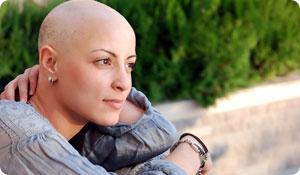
Some drugs used in chemotherapy, such as doxorubicin (Adriamycin), which is almost always used to treat breast cancer, cause complete alopecia, or rapid loss of hair all over the body. Hair loss occurs because the chemotherapy affects all cells in the body—not just the cancer cells. Ask your oncologist if the drugs you will be taking affect your skin or hair because the result usually depends on the drugs and their dosages. If your particular course of chemo causes hair thinning or loss, discuss the pros and cons of shaving your head with the doctor before making a decision.
"I don't usually recommend shaving off your hair prior to chemo," says Los Angeles oncologist Tom Reynolds, MD, FACP. "You don't know how much you will lose, or exactly where, and you may just experience thinning." Waiting may enable you to get a new haircut styled around your actual loss.
It takes about two weeks after the first treatment before hair loss occurs, Reynolds adds. Typically, you will notice clumps of hair coming out in the shower or when you brush. Avoid pulling at your hair, as it will cause large clumps to fall out. Unfortunately, some people lose all their body hair, including eyebrows, eyelashes, pubic, underarm and chest hair.
Wigs and hairpieces can be an attractive option. Salons and stylists that specialize in wigs for people with cancer can be found in most areas, and some health insurance companies help pay for the services. A good wig salon or styling service can match any length and color you desire and create a natural or synthetic wig that flatters your skin and personal style, and fits like your own hair. Call your insurance company's customer service department to find out the policy on payment or reimbursement.
If a wig isn't your thing, maybe an attractive hat is what you need. When breast cancer survivor Pam Abbatiello started chemo treatments, she noticed some of the women at her medical center wearing baseball caps and soft hats; others wore wigs—some good, some not so good. It was rare, she says, to see any bald heads. "My hair was never my crowning glory and I've never liked wearing anything on my head," she admits. "So when my time came, I just cut my hair very short and lived with the fallout." As Abbatiello points out, the decision to go bald—or close to it, as she chose—is also easier to make if you don't go to an office or regularly do business in an environment where a bare scalp will cause a distraction or make you feel overly self-conscious.
(Note: Across Europe and Canada, cold caps are widely used to reduce hair loss in cancer patients. During chemotherapy, the patient straps on a cap that makes the scalp cold and minimizes the amount of chemotherapy drugs that reach the hair follicles. Testing of similar hair-preserving treatments is underway in the US and some doctors are pressuring the FDA to hasten the approval process.)
Whether or not you decide to shave, wear a hat, or apply temporary replacements for other facial hair, such as false eyelashes or brows, your skin and scalp will be very sensitive, and extra care is necessary. Be careful not to rub your head vigorously or avoid pulling on your hair with a comb, brush, or towel. Wash your hair and scalp less often and be sure to use a gentle shampoo. During chemotherapy it's also best not to use blow dryers, curling irons, hair dyes and other hair and scalp treatments.
Care of the scalp is the same as for the face and other tender areas of skin, Reynolds points out. Always apply a like cream for sensitive skin after washing the scalp and avoid unnecessary sun exposure.
Be advised that hair regrowth may be slow, and your hair may be different following treatment. Thick hair may come back thinner. Hair color and texture may change, too. With hormone suppression drugs, hair regrowth may be slower but more complete.
What's important is not to focus too much on hair loss, even as you prepare for it. "Remember that your hair will start to grow again when your treatment is finished," Reynolds emphasizes. "It may grow in curlier or lighter, but you will get it back."
Tom Reynolds, MD, FACP, this article.
Sources:
Stanford Medicine Cancer Institute. "Managing Chemotherapy Side Effects."
http://cancer.stanford.edu/information/cancerTreatment/methods/
managing_effects/hairloss.html
Girl on the Go. "Wigs for Cancer Patients"
http://www.girlonthego.biz/wigs-cancer-patients.php





